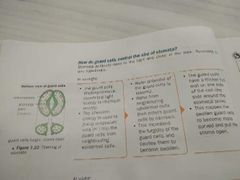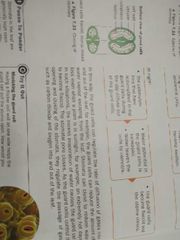![]()
![]()
![]()
Use LEFT and RIGHT arrow keys to navigate between flashcards;
Use UP and DOWN arrow keys to flip the card;
H to show hint;
A reads text to speech;
15 Cards in this Set
- Front
- Back
|
define photosynthesis |
photosynthesis is the process in which light energy absorbed by chlorophyll is transformed into chemical energy. the chemical energy is used to synthesise carbohydrates from water and carbon dioxide. water and carbon dioxide are the raw materials for photosynthesis. oxygen is released during the process. |
|
|
overall equation for photosynthesis |
6CO2 + 6H2O ---> C6H1206 + 6O2 carbon dioxide + water ---> glucose + oxygen |
|
|
glucose in green leaves |
1. converted to sucrose - transport to other parts of the plant for storage - converted to starch or other forms of storage at the storage organs - might be converted back to glucose 2. reacts with nitrates and other mineral salts absorbed from the soil to from amino acids which can be used to form proteins. protein can be stored or used to synthesise new protoplasm (cell surface membrane) 3. forms fats - used in cellular respiration - for storage - synthesise new protoplasm 4. used immediately - for cellular respiration to provide energy for cellular activities - to form cellulose cell walls 5. converted to starch in the leaves, which can be converted back to glucose in darkness when the plant is unable to photosynthesise |
|
|
importance of photosynthesis |
- makes chemical energy available to animals and other organisms - removes carbon dioxide and provides oxygen - energy is stored in fossil fuels through photosynthesis |
|
|
lamina |
has a large flat surface as compared to its volume - thin lamina provides a short diffusion distance for gases and enables light to reach all mesophyll cells |
|
|
lamina |
has a large flat surface as compared to its volume - thin lamina provides a short diffusion distance for gases and enables light to reach all mesophyll cells - broad, providing a large surface area for maximum absorption of light |
|
|
leaf arrangement |
leaves grow either in pairs or singly in an alternate arrangement, hence ensuring that the leaves are not blocking each other from obtaining sunlight |
|
|
petiole |
holds the lamina away from the stem so that the lamina can obtain sufficient sunlight and air |
|
|
waxy and transparent cuticle |
reduces water loss through evaporation from the leaf and is transparent to allow light to enter the leaf |
|
|
more chloroplasts in upper palisade tissue |
more light energy absorbed near the leaf surface can be converted into more chemical energy used in the manufacturing of sugars |
|
|
interconnecting system of air spaces in the spongy mesophyll |
allows rapid diffusion of oxygen and carbon dioxide in and out of mesophyll cells |
|
|
xylem and phloem situated near mesophyll cells |
allows mesophyll cells to obtain water and food substances from xylem and phloem faster |
|
|
thin film of moisture |
allows carbon dioxide to dissolve for diffusion into cells |
|
|
guard cells morning |

|
|
|
guard cells night |

|

